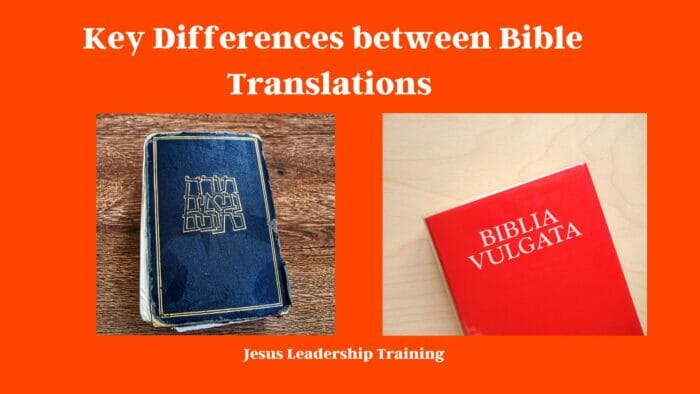Hold on to your hats, folks! We’re about to embark on a deep dive into the world of Bible translations. You’ve probably heard of the King James Version, but did you know there are countless other Bible versions each with its unique nuances? Yes, indeed! Let’s unpack the key differences between Bible translations, shedding light on the distinct characteristics of each version.
Table of Contents
Key Differences between Bible Translations
Translation Philosophy: Word-for-Word vs. Thought-for-Thought
Before we delve into the nitty-gritty, it’s essential to understand the philosophies behind Bible translation. It’s a balancing act between word-for-word, which aims for literal accuracy, and thought-for-thought, which focuses on conveying the original message in contemporary language.
The Middle Ground: Optimal Equivalence
Some translations attempt to strike a balance between the literal and thought-for-thought approach, aiming for optimal equivalence. These translations try to blend the best of both worlds.

Comparing the Translation Spectrum
Literal Translations
Considered the backbone of Bible translations, these versions stick as closely as possible to the original text. Here are a few examples:
- New American Standard Bible (NASB)
- English Standard Version (ESV)
- King James Version (KJV)
Dynamic Translations
Falling further along the spectrum, these translations prioritize conveying the meaning of the original text in an easily understandable way. They include:
- New International Version (NIV)
- New Living Translation (NLT)
- Good News Translation (GNT)

Assessing Readability and Formality
Different translations offer varying degrees of readability and formality. The way these versions strike a balance between these two factors often reflects their target audience and intended usage.
Academic and Formal Use: High Formality, Low Readability
The King James Version (KJV) and the New American Standard Bible (NASB) are prime examples of this category. They often serve as academic or liturgical resources.
Personal Study and Devotion: Moderate Formality, High Readability
These versions like the New International Version (NIV) and the New Living Translation (NLT) are user-friendly, making them ideal for personal devotion and Bible study.
Historical Context of Bible Translations
Every translation reflects the era in which it was created, influencing language style, interpretation, and the inclusion or exclusion of certain books.
The King James Version: A Historical Masterpiece
The KJV is a quintessential example of a historical translation. Created in 1611, its poetic language and traditional phrasing have stood the test of time.

Contemporary Translations: A Reflection of Modern Times
More recent translations like the New Living Translation (NLT) and The Message (MSG) incorporate contemporary language and idioms, making them more accessible to modern readers.
Understanding Theological Bias in Translations
All translations carry a degree of theological bias. It’s unavoidable, given that translators are human beings with personal beliefs and understandings.
Translations with a Conservative Bias
Certain versions like the New American Standard Bible (NASB) are noted for their conservative bias.
Translations with a Liberal Bias
Conversely, translations like The Message (MSG) are often seen as having a liberal bias, focusing more on conveying the spirit of the text rather than literal accuracy.
The Impact of Translation on Biblical Interpretation
The translation you choose will significantly influence your interpretation of the Bible’s teachings.
How Literal Translations Influence Interpretation
Choosing a literal translation like the English Standard Version (ESV) may enhance your understanding of the original biblical languages.
How Dynamic Translations Influence Interpretation
Alternatively, dynamic translations like the Good News Translation (GNT) can make the Bible’s teachings more relatable and understandable in a modern context.
Frequently Asked Questions
Q: How many different Bible translations are there? A: As of now, the Bible has been translated into over 700 different languages with numerous versions in each language.
Q: Which Bible translation is the most accurate? A: This is subjective and depends on what you mean by “accurate”. If you’re referring to literal accuracy, then the New American Standard Bible (NASB) is often cited. However, if you’re looking for a translation that accurately conveys the thought of the original text in today’s language, then the New Living Translation (NLT) is a popular choice.
Q: Is the King James Version of the Bible the best? A: The KJV is revered for its literary beauty and historic value. However, whether it’s the “best” depends on personal preference and the purpose of your reading.
Q: Do different Bible translations change the message of the Bible? A: Different translations can offer varied interpretations of certain passages, but the central message of the Bible remains consistent across translations.
Q: Why are there so many Bible translations? A: The multiplicity of Bible translations reflects the desire to make the Bible accessible to various audiences, taking into account differences in language, culture, and comprehension levels.
Q: Which Bible translation is easiest to understand? A: The New Living Translation (NLT) and The Message (MSG) are often recommended for their easy-to-understand language.
Conclusion
Navigating the world of Bible translations can feel like a high wire act. However, understanding the key differences between Bible translations can enrich your spiritual journey, allowing you to engage with the Bible in a way that resonates with you. Whether you’re an academic scholar, a spiritual seeker, or someone seeking comfort in sacred words, there’s a translation out there that will speak to your heart and mind.



